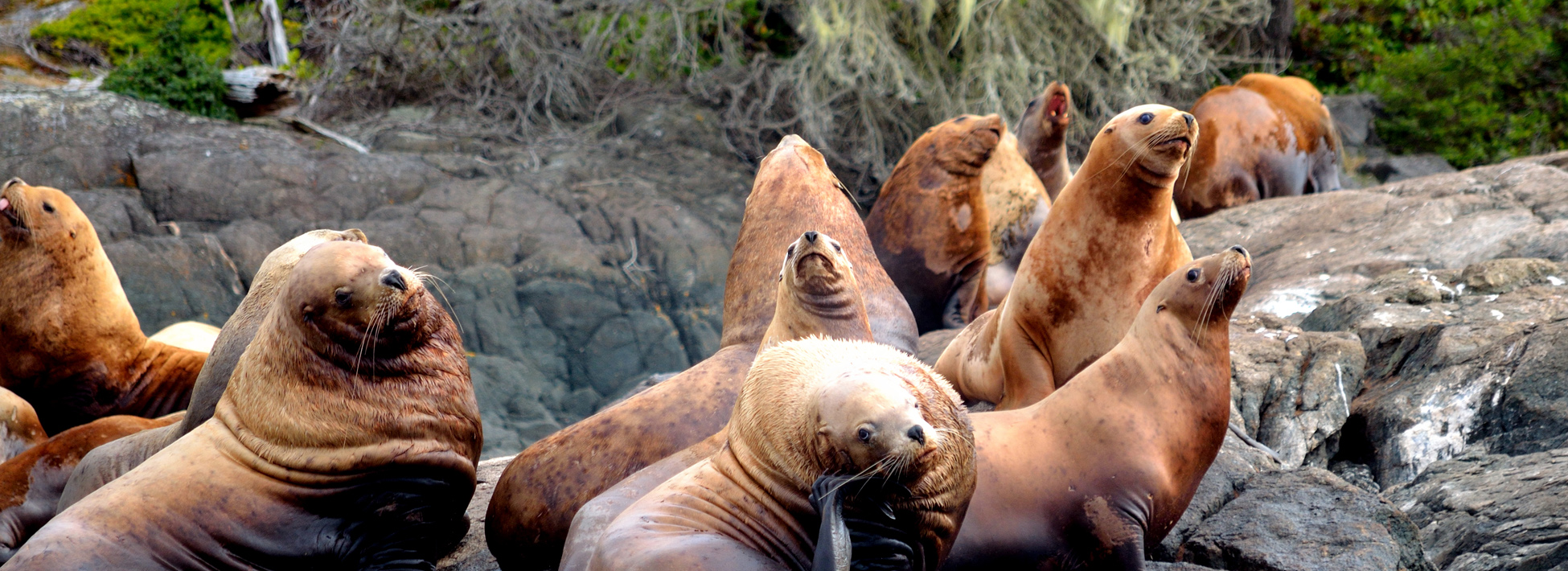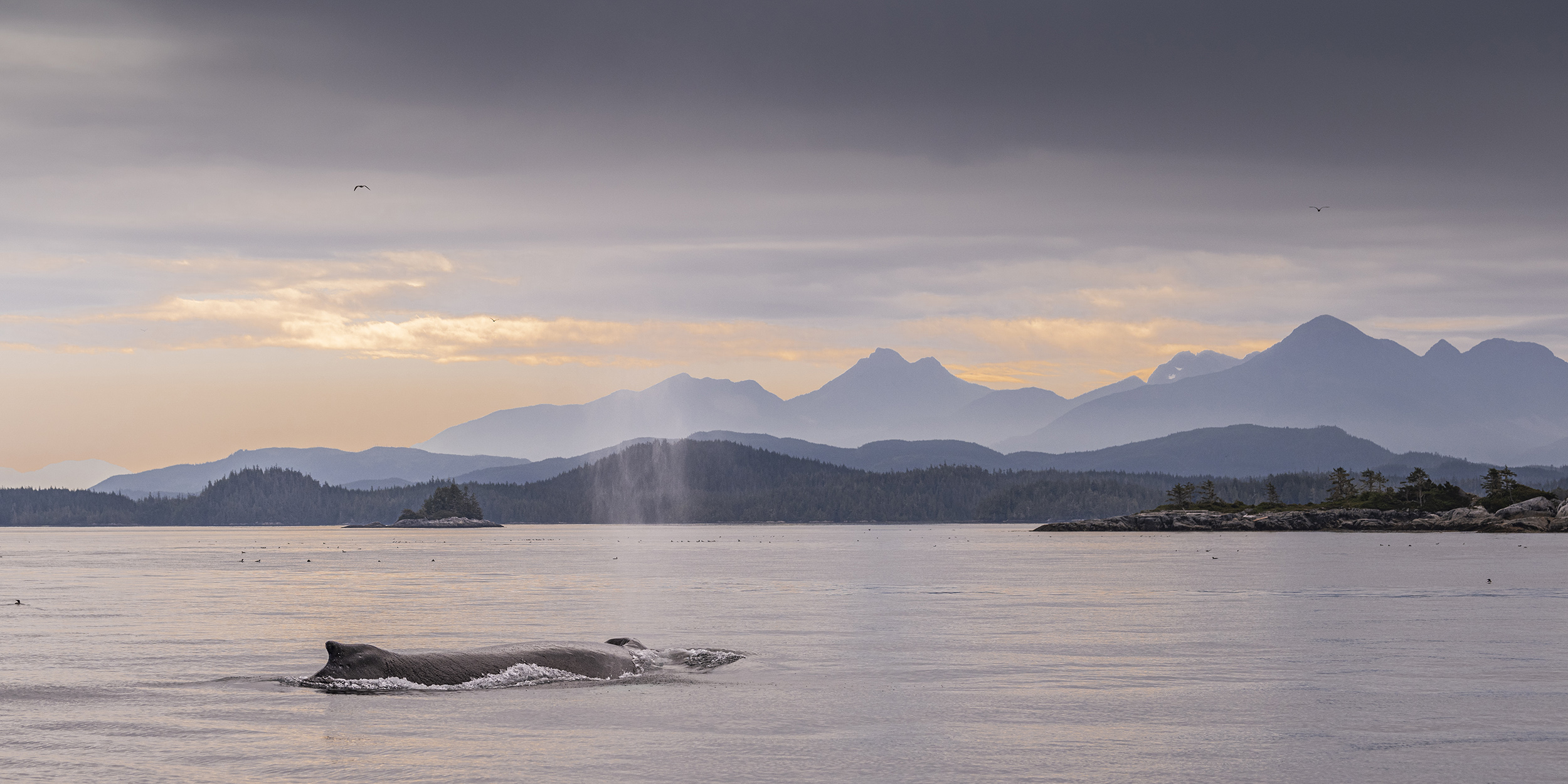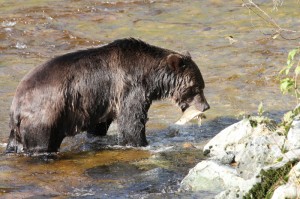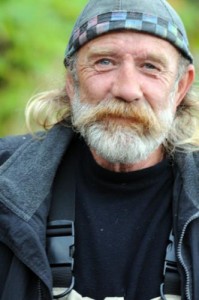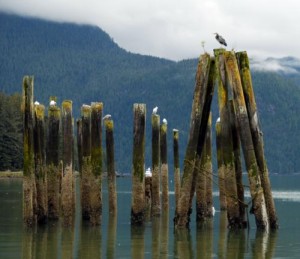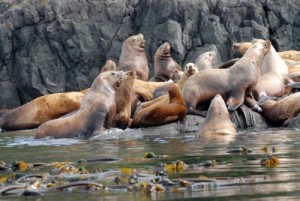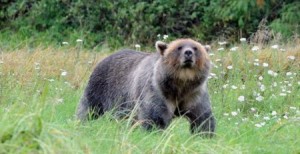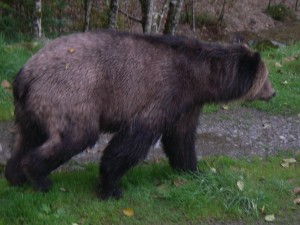The area Grizzly Bear Lodge uses for viewing bears in the fall is on Knight Inlet’s Glendale River. The viewing stands are a fifteen minute van ride up the river and are located right on the river a few meters (yards) from the waters edge. Some parts of the viewing area are in shallow water where the bears are seen chasing the salmon and catching them on the surface. This takes quite a bit of energy and time as the fish are fast. Other bears prefer to conserve their energy and fish in the deep water, which requires bears to dive to pick up dead or wounded salmon that have drift down from up stream. When deep water fishing it is often easier to walk to shore to eat than constantly diving to retrieve the dropped meat. James O’Donoghue of the UK provided this photo.
Grizzly Bear and Wildlife Viewing Blog: Monthly Archives: March 2013
The extra day and memories with“The Trapper”
If stay the extra night at our lodge the extra day is a river day spent at a “wild” river on a wilderness tour. Crossing Knight Inlet we travel the length of Thompson Sound to the Kakweikan River and spend a day with The Trapper. Rick has spent a good part of his life on this river and protects it with a passion. Grizzly Bear Lodge is the only lodge in the area with access to this river. The scenery on this part of BC’s mainland in breathtaking and the wildlife viewing provides a reasonable chance of grizzly bear sightings. Bears are often seen below the falls at Rick’s cabin or on the road to the cabin. Seeing a grizzly bear at Rick’s is a different sensation than see one from a protected viewing stand on Knight Inlet’s Glendale River. Maybe that is why Rick always has “Rosemarie” with him. Who is “Rosemarie” that you will have to ask Rick?
Glendale River Knight Inlet BC
This is a scene of peace and serenity, the was picture taken by guest Debbie Zygmunt from the dock in the estuary of the Glendale River on Knight Inlet. The grizzly bear tours leaving Grizzly Bear Lodge travel for about an hour up Knight Inlet to the Glendale. We spend the morning and part of the afternoon viewing grizzly bears in the estuary in the spring or on the river in the fall after the pink salmon have arrived. A picnic lunch is served on the dock each tour at mid day. The pilings in the picture are located near the end of the dock supported the original landing for a logging camp the was on the shore up until the nineteen fifties. The shore opposite the dock has similar pilings from a salmon cannery that operated in the nineteen twenties.
Grizzly Bear in tall Sedge Grass
No this is not a cub but rather an adult grizzly bear sitting in sedge grass. The grass in the estuary of Knight Inlet’s Glendale River is better than a meter (3 feet) high. In the spring bears come to this area to feed on the sedge grass is it up to 25% protein and as the berries in the coastal forests are not yet available this is the reason why grizzly bears are in the estuary. At lower tides when more of the beach is exposed the bears will spent more time turning over rocks in the inter-tidal zone looking for food high in protein such as crab, clams, barnacles, amphipods and other tiny invertebrates. Much a grizzly’s time in the spring is spent in search of food this changes in the fall once the salmon arrive and food is more abundant. Photo by guest Debbie Zygmunt.
Whale Watching Safair with Steller Sea lions
If grizzly bears have a classic pose so do sea lions and Debbie Zygmunt has captured both: lying head down and sleeping or the up and alert lion pose. Steller sea lions are common in Johnstone Strait especially in an area close to Telegraph Cove known as Stubbs Island. As seen in the photos above and backed by “Wikipedia, the free encyclopedia: Adult females measure 2.3–2.9 m (7.5–9.5 ft) in length, with an average of 2.5 m (8.2 ft), and weigh 240–350 kg (530–770 lb), with an average of 263 kg (580 lb).[2][3] Males continue to grow until their secondary sexual traits appear in their fifth to eighth year. Males are slightly longer than the females; they grow to about 2.82–3.25 m (9.3–10.7 ft) long, with an average of 3 m (9.8 ft).[4] Males have much wider chests, necks and general forebody structure and weigh 450–1,120 kg (990–2,500 lb), with an average of 544 kg (1,200 lb).”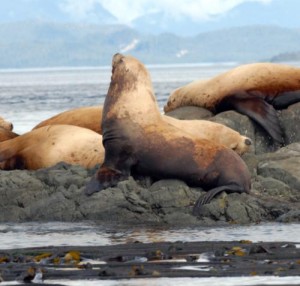
Classic Grizzly Bear Pose Knight Inlet
Guest Debbie Zygmut has taken a picture of the classic grizzly bear pose in the estuary of the Glendale River part the Knight Inlet river systems. Standing in the sedge grass head up trying to catch our scent. A grizzly bears sense of smell is better than a dogs as National Geographic says: “Grizzly bears have “dish-shaped noses” with a sense of smell seven times stronger than a bloodhound’s.” A common misconception is that bears have poor eyesight. The reasons behind this may be that their sense of smell is so good they need to rely less on eyesight, but evidence indicates that bears’ eyesight is comparable to humans.
Grizzly Bear Siblings NOT sharing salmon
As stated in yesterdays post; although the grizzly bear siblings may spend their first three or four years together it does not mean they will share their salmon catch. Sleeping and denning together is one thing but food is survival and that becomes an individual matter. It is common to see the sibling sub-adults traveling together in the spring in Knight Inlet’ Glendale River estuary and even on the river later in the fall when the pink salmon arrive in the river. They may have shared their mother’s food but not the food they catch.
Grizzly Bear Siblings Salmon Fishing
Alone and vulnerable sibling grizzly bears of the Knight Inlet area often stay together until they are three or four years old often fishing, eating and sleeping side-by-side, and even denning together. The average breeding age for female grizzlies is 4.5 years. Males reach sexual maturity at roughly the same age as the females. Sub-adult females tend to establish home ranges within or overlapping their mother’s home range. Sub-adult males are usually discouraged from staying in the same area by the larger males and must travel large distances to establish a home range. And even though these sub-adult males are capable of breeding at three or four years of age, they rarely have the opportunity to do so because of these older, bigger males.
Large Male Orca on Whale Watching Safari
The day whale watching means we travel to the area of Johnstone Strait near Telegraph Cove on Vancouver Island BC. The resident, salmon eating orca, arrive in early late June and stay through October while the transient, mammal eating orca are in the area all year. Confused? The first serious study of the orca populations in the mid-1970’s started as a summer study so when the scientist arrived in July and left in September the orca were always in the area and therefore there named resident orca. Little did they know that this was a summer feeding area as the orca followed the salmon? The transient orcas, which were in the area, spend more time in the remote inlets in the summer because there was more boat traffic. The transient orca still travel through our viewing area in the summer but this photo is of a resident as determined by the size and shape of its dorsal fin, taller and narrower at the base. Photo provide by guest Alferd Bittner.
Grizzly Bear Identification Knight Inlet
Another day another grizzly bear close to the viewing stands. No I am not trying to pass yesterdays post off as a different bear this one has a leaf on it’s back. Actually if you look at the shoulder you will notice this bear does not have the light patches on the fur on it’s neck or behind the shoulder. Coat colours and a variety of colour patches on their body identify the bears in our viewing area. Unlike bears in other areas in BC or Alaska our bears are nearly scar free. There is sufficient food that they do not fight enough to hurt or leave scars rather they just get aggressive enough to move bears to another part of the river.
